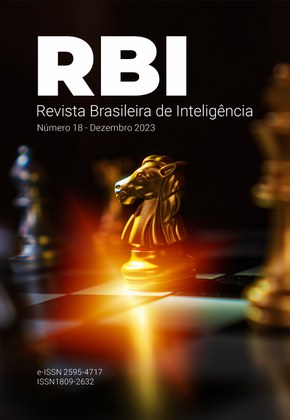LA actividad de inteligencia y los retos de uma sociedad conectada por el caos
el aprendizaje automático y el análisis de redes como recurso auxiliar
DOI:
https://doi.org/10.58960/rbi.2023.18.226Palabras clave:
aprendizaje automático; Inteligência; noticias falsas.Resumen
Las redes sociales son capaces de impactar positiva y negativamente en los escenarios sociales, políticos y económicos de un país. El gran flujo de información que circula en estos entornos hace imposible llevar a cabo operaciones de lucha contra la desinformación y las fake news únicamente mediante la acción humana. En este contexto, el objetivo de este artículo es explorar los modelos y herramientas que pueden ser utilizados por la comunidad de inteligencia para recopilar, analizar y difundir conocimiento en medio de una dudosa calidad de los contenidos producidos por la Inteligencia Artificial. El objetivo de este artículo es explorar los modelos de aprendizaje automático que representan valiosas herramientas auxiliares para vigilar en tiempo real oportunidades y las amenazas de desinformación.
Descargas
Citas
ALLEN, Greg; CHAN, Taniel. Artificial Intelligence and National Secururity. Cambridge: Harvard Kennedy School. Belfer Center for Science And International Affairs, July 2017.
ANDERSON, Monica et al. Focus groups: Social media stirs a range of emotions and reactions in teens. Pew Research Center, Washington, DC, 16 nov. 2022.
ARGUEDAS, Amy Ross et al. Echo chambers, filter bubbles, and polarisation: a literature review. Oxford: Reuters Institute, Jan. 2022.
BHUTANI, Bhavika et al. Fake News Detection Using Sentiment Analysis. In: Twelfth International Conference on Contemporary Computing (IC3), Noida, 2019. DOI: https://doi.org/10.1109/IC3.2019.8844880
BRODY, Dorje C.; MEIER, David M. Mathematical models for fake news. Disponível em: https://arxiv.org/pdf/1809.00964. Acesso em: 19 out. 2023.
CHITRA, Jain, Arihant. Fake News detection using naive bayes classifier. Journal of Analysis and Computation (JAC), vol. XIV, issue -VI, 2020. Disponível em: www.ijaconline.com. Acesso em: 19 out. 2023.
EHMAKE, Rachel. How Using Social Media Affects Teenagers. Child Mind Institute. Disponível em: Social Media Effects on Teens | Impact of Social Media on Self-Esteem (childmind.org). Acesso em: maio 2023.
GONÇALVES, Joanisval Brito. A Atividade de Inteligência no combate ao crime organizado: o caso do Brasil. Disponível em: http://www2.senado.leg.br/bdsf/handle/id/103. Acesso em: 19 out. 2023.
GRUPPO, Meaghan. Intelligence Sourcing Basics: A Primer as Generative AI Pollutes the Internet to Death. Disponível em: https://substack.com. Acesso em: maio 2023.
HARDY, John. Hunters and Gatherers: the evolution of strike and Intelligence functions in special operations forces. International Journal of Intelligence and CounterIntelligence, v. 36, n. 4, p 1143-1163. 2023. DOI: https://doi.org/10.1080/08850607.2023.2197558
HEIKKILA, Melissa. How AI-generated text is poisoning the internet. MIT Technology Review. Dez. 2022.
HVITVED, Sophie. What if 99% of the metaverse is made by AI? Scenario magazine, Copenhagen, 24 fev. 2022.
JARDINE, Érico. Beware Fake news. Platform governance, security, Centre for International Governance Innovation. Disponível em: https://www.cigionline.org/aticles/beware –fake-news/. Acesso em: abril 2023.
KRESNAKOVA, Viera Maslej et al.Deep learning methods for Fake News detection. In: IEEE International Symposium on Computational Intelligence and Informatics. Hungria, 2019. DOI: https://doi.org/10.1109/CINTI-MACRo49179.2019.9105317
LOKHANDE, Samiksha. Noções básicas de PNL (Processamento de Linguagem Natural). Disponível em: medium.com. Acesso em: maio 2023.
NEWBERY, Samantha; KAUNERT, Christian. Critical Intelligence Studies: a new framework for analysis. Intelligence and National Security, v. 38, n. 5, p. 780-798, 21 feb. 2023. DOI: https://doi.org/10.1080/02684527.2023.2178163
ORTIZ-OSPINA, Esteban. The rise of social media. Our World in Data, 18 sept 2019. Disponível em: https://ourworldindata.org/rise-of-social-media. Acesso em: 19 out 2023.
OSHIKAMA, Ray; QUIAN, Jing; WANG, William Yang. A Survey on Natural Language Processing for Fake News Detection: computation and language. In: Conferência de Recursos e Avaliação Linguística, 2020. Disponível em: https://doi.org/10.48550/arXiv.1811.00770. Acesso em: 19 out. 2023.
ROMERO, Alberto. Generative AI Could Pollute the Internet to Death. Disponível em: substack.com. Acesso em: maio 2023.
SANTOS, Roney Lira de Sales; PARDO, Thiago Alexandre Salgueiro. Structural Characterization and Graph-based Detection of Fake News in Portuguese. In: Simpósio Brasileiro de Tecnologia da Informação e da Linguagem Humana. Porto Alegre: Sociedade Brasileira de Computação, 2021. DOI: https://doi.org/10.5753/stil.2021.17799
SHRIVASTAVA, Gulshan et al. Defensive Modeling of Fake News Through Online Social Networks. IEEE Transactions on Computational Social Systems, vol. 7, n. 5, pp. 1159-1167. 2020. DOI: https://doi.org/10.1109/TCSS.2020.3014135
SIVASANKARI S.; VADIVU, G. Tracing the fake News propagation path using social network analysis. Soft Comput, v. 26, n. 23, p. 12883–12891, 2022. DOI: https://doi.org/10.1007/s00500-021-06043-2
SMALDINO, Paul E. Modeling Social Behavior: Mathematical and Agent-Based Models of Social Dynamic and Cultural Evolution. Princeton University Press.2023 THOTA, Aswini et al. Fake News Detection: a deep learning approach. SMU Data Science Review, v. 1, n. 3, 2018. Disponível em: https://scholar.smu.edu/datasciencereview/vol1/iss3/10/. Acesso em: 19 out. 2023.
WASSERMAN, Stanley; FAUST, Katherine. Social Network Analysis: methods and applications. Cambridge University Press, 1994. DOI: https://doi.org/10.1017/CBO9780511815478
WATSON, Amy. Encountering fake news in print media worldwide 2019, by country. Statista, 03 Jun. 2022a.
WATSON, Amy . Share of adults who have witnessed fake news in print media worldwide as of January 2019, by country. Statista, 03 Jun. 2022b.
WATSON, Amy . Perceived frequency of online news websites reporting fake news stories in the United States as of March 2018. Statista, Abr. 2018.
ZERVOPOULOS, A. et al.. Hong Kong Protests: using natural language processing for fake News detection on twitter. In: MAGLOGIANNIS, I.; ILIADIS, L.; PIMENIDIS, E. (ed.). Artificial Intelligence Aplications and Innovations. AIAI 2020. IFIP Advances in Information and Communication Technology, v. 584. Springer, Cham. Disponível em: https://doi.org/10.1007/978-3-030-49186-4_34. Acesso em: 19 out. 2023 DOI: https://doi.org/10.1007/978-3-030-49186-4_34









